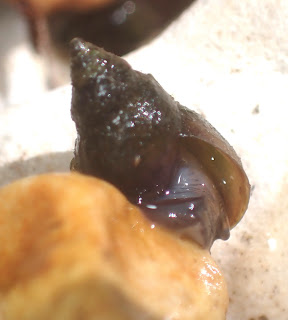 Walking along the edge of Bull Creek I discovered a large snail nursery. It was a 60 foot stretch of gravel 5 feet wide ending at the fast flowing stream. Tiny newborn snails covered the rocks and I counted 150+ snails in each of two one foot square plots. Assuming these were average densities, I would estimate there were around 45,000 baby snails. You can see the bed in this video.
Walking along the edge of Bull Creek I discovered a large snail nursery. It was a 60 foot stretch of gravel 5 feet wide ending at the fast flowing stream. Tiny newborn snails covered the rocks and I counted 150+ snails in each of two one foot square plots. Assuming these were average densities, I would estimate there were around 45,000 baby snails. You can see the bed in this video.

Chris Barnhart and Deb Finn identified these as Elimia potosiensis (EP). These are widespread in the White River drainage and mostly limited to a four state area below. They are in the Pleuroceridae family of small to medium-sized freshwater gilled snails.
"According to Dillon (2000), Pleuroceridae feed
on detritus or the algae growing on hard
surfaces, and many seem to be able to feed on
both. The family is characterized by having two
sexes, male and female, but with no outward
expression of gender. Reproduction is
iteroparous, meaning that they may do so several
times throughout their multi-year lifespans.
Fertilization may occur by males releasing sperm
directly into the environment, as mating
behaviour has never been observed. Eggs are laid
on a hard surface, for example the underside of
stones, and develop into tiny snails without a
larval stage." Molluscan shells
 Our EP snails were dextral or "right-handed" snails, meaning that when you hold them to look at the opening, the shell spirals off to the right. Over 90%[1] of gastropod species have shells in which the direction of the coil is dextral (right-handed). These are gilled snails which thrive in our fast moving Ozark streams that have higher dissolved oxygen levels.
Our EP snails were dextral or "right-handed" snails, meaning that when you hold them to look at the opening, the shell spirals off to the right. Over 90%[1] of gastropod species have shells in which the direction of the coil is dextral (right-handed). These are gilled snails which thrive in our fast moving Ozark streams that have higher dissolved oxygen levels.
Sinistral (left-handed) pulmonate or "lunged" pond
snails lack gills and many crawl to the water surface to take in air. They are widespread,
abundant, and tolerant of pollution and low levels of dissolved oxygen. We have never found them on our Bull Creek Stream Team studies but they are the predominate snails found in Wilson's Creek. http://mkohl1.net/Physidae.html
Now here is where it gets interesting. E. potosiensis were studied in Arkansas and demonstrated phenotypic plasticity in a very short stretch of a stream from a spring. In case you aren't familiar with that term (I wasn't), in the case of our snails it refers to the finding that shell shape and structure is different in different stream segments. In this study the snail shells in the shallow gentler headwater reaches were thinner, less inflated and smoother, with smaller openings, possibly reducing the risk of predation. Downstream where there was heavier flow and more turbulence the shells were more inflated, thicker and more sculpted. Other studies have suggested these shells are less likely to be dislodged and damaged by tumbling.
Snails are the Rodney Dangerfields of the animal world, in need of a better press agent. Even sites like Snail World have only a little information. My favorite poem from childhood some 70+ years ago probably sums up the status of a snail.
""James gave a huffle of a snail in danger and no one heard him at all." - The Four Friends - A.A Milne
Please read the short poem The Four Friends. Snails need your support.
Snails in Wikipedia Phenotypic Plasticity in Encyclopedia of Ecology
 I
put it in a bug box and left it in the refrigerator for several hours,
then photographed it close up. It measured just 9 mm in body length. A
quick Google brush-up on insect anatomy reminded me that the red genae is
the "lateral part of the head of an insect or other arthropod below the level of the eyes." "Red-lipped......Bingo!"
I
put it in a bug box and left it in the refrigerator for several hours,
then photographed it close up. It measured just 9 mm in body length. A
quick Google brush-up on insect anatomy reminded me that the red genae is
the "lateral part of the head of an insect or other arthropod below the level of the eyes." "Red-lipped......Bingo!"



.jpeg)





.jpeg)






